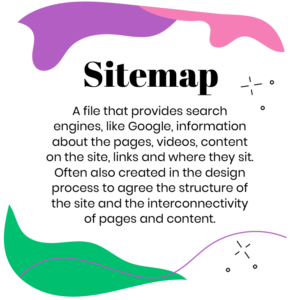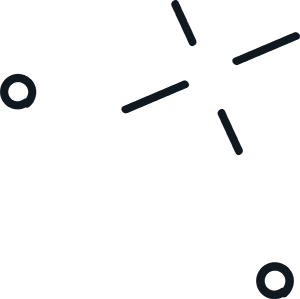Find yourself nodding in web design and development conversations without understanding the lingo?
It’s ok. We’ve all been there. Keep our handy web-tech jargon glossary close to hand and nod confidently in future conversations!
Web Glossary
HTML (Hypertext Markup Language)
The standard markup language used to create web pages, defining the structure and content of a webpage.
SEO (Search Engine Optimisation)
Techniques and strategies employed to increase a website’s visibility and ranking in search engine results, thereby driving organic traffic.
Alt Text
Descriptive text added to an image tag in HTML to provide information about the image for accessibility purposes.
API (Application Programming Interface)
A set of rules and protocols allowing different software applications to communicate and interact with each other. Web APIs are commonly used to integrate external services and access data.
Analytics
Tools (such as Google Analytics, Matomo, Fathom for example) and metrics used to track, measure and analyse website traffic and user behaviour, providing insights for optimising performance and user experience.
Assets
Includes images, videos, digital documents, audible content, animations and videos stored in applications or online.
Backend
The side of a website or application responsible for processing requests, managing data, and performing other administrative operations. This aspect is for site admins and is kept well away from visitors.

CDN (Content Delivery Network)
A group of worldwide servers that keep a copy of your website and distribute it to the visitors to the website nearest to them, making loading time faster and able to handle high traffic better.
CMS (Content Management System)
An application to modify and manage website and application content, allowing contributors to create, edit and publish.
Content
Everything that appears on a website, including copy, pictures, video, products and audio. Content gives a website personality and individuality, helping to differentiate your website from others.
Content block
Groups of layout containers created for the purpose of building web pages. They can contain text, images, video or animations and are designed to provide different layouts for numerous purposes.
Cookie
A small piece of data stored on a user’s device by a website to track user preferences, authentication, and other purposes.
Copy
Effective copy communicates who you are and details the products or services you offer in a compelling manner. Creative use of words, phrases and sentences should entice, engage, and encourage some form of set action, such as clicking through, signing up, making a purchase, or interacting with your site.
DNS (Domain Name System)
The phonebook of the internet. It converts alphabetic names into numeric IP addresses which browsers use to load internet pages. DNS servers make it possible for people to input normal words into their browsers, such as alivewithideas.com, without having to keep track of the IP address for every website.
Frontend
The client-side portion of a website or application that users interact with directly, including the content, layout, design, and interactive elements.
FTP (File Transfer Protocol)
A way to download, upload, and transfer files from one location to another on the Internet and between computer systems.

Functionality
Features put in place to improve the user’s experience, aid navigation, support finding relevant content, make effective purchases and generally improve the site’s experience. Functionality also applies to the ease of use for those using the backend of a website.
Grid System
A framework used to align and organise content on a web page into columns and rows.
Hosting
Is where the files of your website are stored. A hosting provider allocates space on a web server (or an entire server) for a website or app to store its files (code, images, etc.) for viewing online in a chosen URL. Providers are selected based on the required specifications, such as size, volume of traffic, complexity, security etc…
IP (Internet Protocol) Address
Every device connected to the internet has its own unique identifying number (IP), which is used by other devices to locate the device. An Internet Protocol address is a numerical label such as 192.0.2.1.
JavaScript
A programming language commonly used to create interactive effects within web browsers, enhancing the functionality of web pages.
Meta Tags
HTML tags that provide metadata about a web page, such as its title, description and keywords.
Page templates
A website page template lets content producers generate custom pages based on an agreed layout or design. Page templates can support various forms of content, providing a structure and appearance to work within.
Responsive design
An approach to web design that makes web pages easy to view on a variety of devices and window or screen sizes, from minimum to maximum display size, to ensure a positive user experience.
SSL (Secure Sockets Layer)
Used to establish encrypted links between a web server and a browser, ensuring secure data transmission, commonly indicated by “https://” in URLs.

Sitemap
A file that provides search engines, like Google, information about the pages, videos, content on the site, links and where they sit. Often also created in the design process to agree the structure of the site and the interconnectivity of pages and content.
System integrations
Creating and building a website architecture that allows certain platforms, software or features from a third party to be used on your site.
Test site
As the name suggests, the test site allows you to see, test and tweak your site without any visibility from your audience. A safe way to test the changes required to your live site, before publishing for the world to see.
URL (Uniform Resource Locator)
A unique identifier used to locate a resource on the Internet. It is also referred to as the web address.
UI (User Interface)
Visual elements and design of a website or application through which users interact, including buttons, forms, menus and other interactive components.
UX (User Experience)
A user’s overall experience when interacting with a website, including ease of use, accessibility and satisfaction.
Web accessibility
The practice of making information, activities, and/or environments sensible, meaningful and usable for as many people as possible.
WCAG (Web Content Accessibility Guidelines)
An internationally recognised set of recommendations for improving web accessibility for people with disabilities.
Wireframes
A framework or skeleton of a website that shows its components and functionality. They are created early in the design process to agree on the structure of the site and pages.
Get in touch:
Need further insight or expertise? Reach our team of experts at hello@alivewithideas.com.
Learn more about our web services and view examples of websites we have created at alivewithideas.com/websites
















